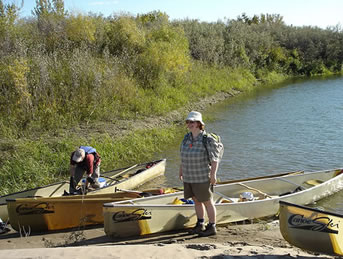Southern Waterways Canoe Trips
South Saskatchewan Cranes & Colors
“The trip was full of sensations, far removed from my everyday patterns. The heat of the sun, bursts of scent from sage and dry grasses on the nature walk, and the river with its wildlife and colorful landscapes had packed all of a short Canadian summer into one long memorable fall day.” You’ll find Christine’s reflections on the September Cranes & Colors day trip on the South Saskatchewan River an interesting read. She also enjoyed the numerous flocks of noisy Sandhill Cranes and the noon-day corn roast on the river bank.
An Elemental Fall Journey on the South Saskatchewan River
by Christine Varnum, September 2005

Christine, tired but happy after a memorable fall journey on the South Saskatchewan River (Photo: Stephen Urquhart)
Our day-long canoe trip down the South Saskatchewan River ended during sunset on a glorious September day, but really began on a rainy July day on the Churchill River. That wet July day, my spouse and I spent an hour paddling to the Holy Trinity Church at Stanley Mission and admiring the steep granite cliff to the north. This delightful and peaceful jaunt reminded us just how much satisfaction there is in paddling, but also just how many years it had been since we had done any canoeing.
Back in Saskatoon, I studied Cliff Speer’s CanoeSki website carefully, looking for an interesting trip that wasn’t too hard, to serve as a re-introduction to paddling. The fall Cranes and Colors trip sounded just right — on our doorstep and about the right length time-wise. I emailed Cliff to let him know we were interested.
The group met on a Sunday morning. Cliff certainly picked the best day for this trip as the weather was warm and the skies were clear and vividly blue. He supplied all the canoeing equipment, lunch, and arranged van shuttling and an accompanying naturalist, Anna Leighton. We drove south past Beaver Creek (our take-out point) to a quiet bay off the river near Chief Whitecap Reserve.
Everyone helped unload the canoes and distribute gear, packs, and paddling partners. Cliff matched up the eight people in four canoes with an eye to experience and skill, which ranged from absolutely none to several experienced canoeists. He led us in a review of paddling strokes, which also warmed up the necessary muscles. One by one, the canoes loaded up and my husband Stephen and I took our first strokes out towards the river channel, pausing just before reaching the main current.
While waiting there for the rest of the canoes, I saw two harbingers for the rest of the trip. A jewel-bright kingfisher flew above our heads — a reminder to look up and away at the sky, the shorelines, and the horizons. A couple of red ladybugs rested on the horsetail stems poking up through the water around the canoe — a reminder to look down and close at the water and earth nearby.
Cliff led the canoes out into the river channel and we started downstream. The paddling was easy as the current was strong and contributed greatly to our speed. Within an hour, we headed to shore at our lunch spot. We scrambled up a sandy bank to grassy, level ground carrying coolers, campfire tools and a bag of fresh corn. After stretching our legs a bit, Cliff organized us into preparing for the cook-out. Some scythed tall grass, some dug a fire pit, while others wrapped corn cobs in foil or collected firewood and kindling. We feasted on roasted corn, smokies, salads and deserts.
After a delicious and filling meal, Anna took us exploring down a forest trail. We were fortunate that Cliff was able to get her to come along. She is one of Saskatchewan’s foremost botanists and had just co-authored a book on the western red lily. She pointed out flowers, shrubs, and trees, giving us their names and other tidbits such as local First Nations uses. The highlight for me was a wolf spider den. What we could see was a hole in the ground, about the size of a penny. The impressive part is that the hole was a foot deep — a huge task for a spider in sandy, shifting soil.
We returned to the canoes and to our downstream drifting. A small line of swift, white Tundra Swans flew over the river and us. At times, the river stretched out broad and lake-like, once it cut through a glacial moraine, giving us startling high sand cliffs. A Bald Eagle circled over the cliffs, placing the bird and the cliffs in perspective. We saw flocks of Sandhill Cranes and Canada Geese, some flying overhead or resting on sandbars. Astonishingly, we paddled past a second eagle, sitting on a sandbank not far from the seemingly nonchalant Sandhills.
The trip was full of sensations, far removed from my everyday patterns. The heat of the sun, bursts of scent from sage and dry grasses on the nature walk, deep guttural tones of the cranes and all around the smells and vivid colors of fall in full bloom. I finished the day tired – the current and the paddling spouse didn’t do all the work to get our canoe back to Beaver Creek – but thoroughly satisfied. Cliff’s leadership experience, the surprisingly hot weather, and the river with its wildlife and colorful landscapes had packed all of a short Canadian summer into one long memorable fall day.














